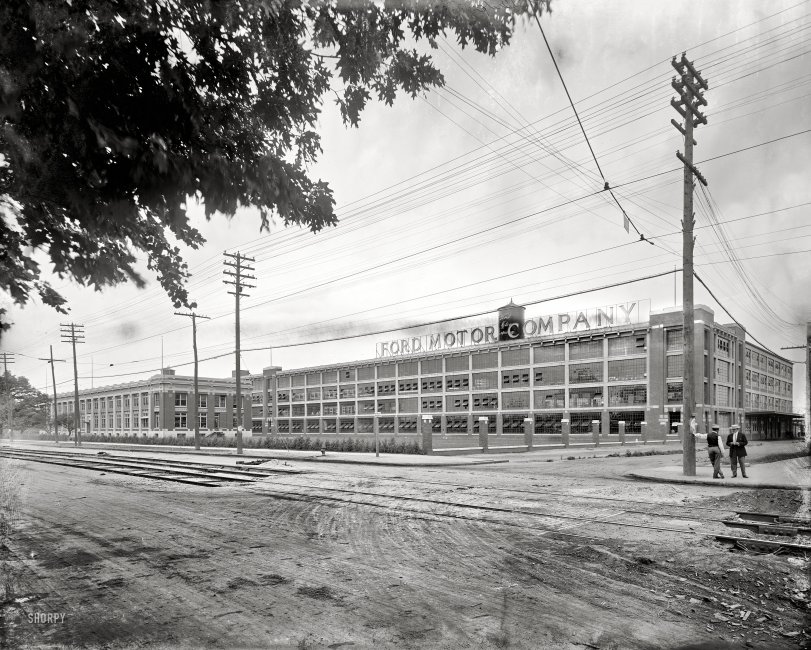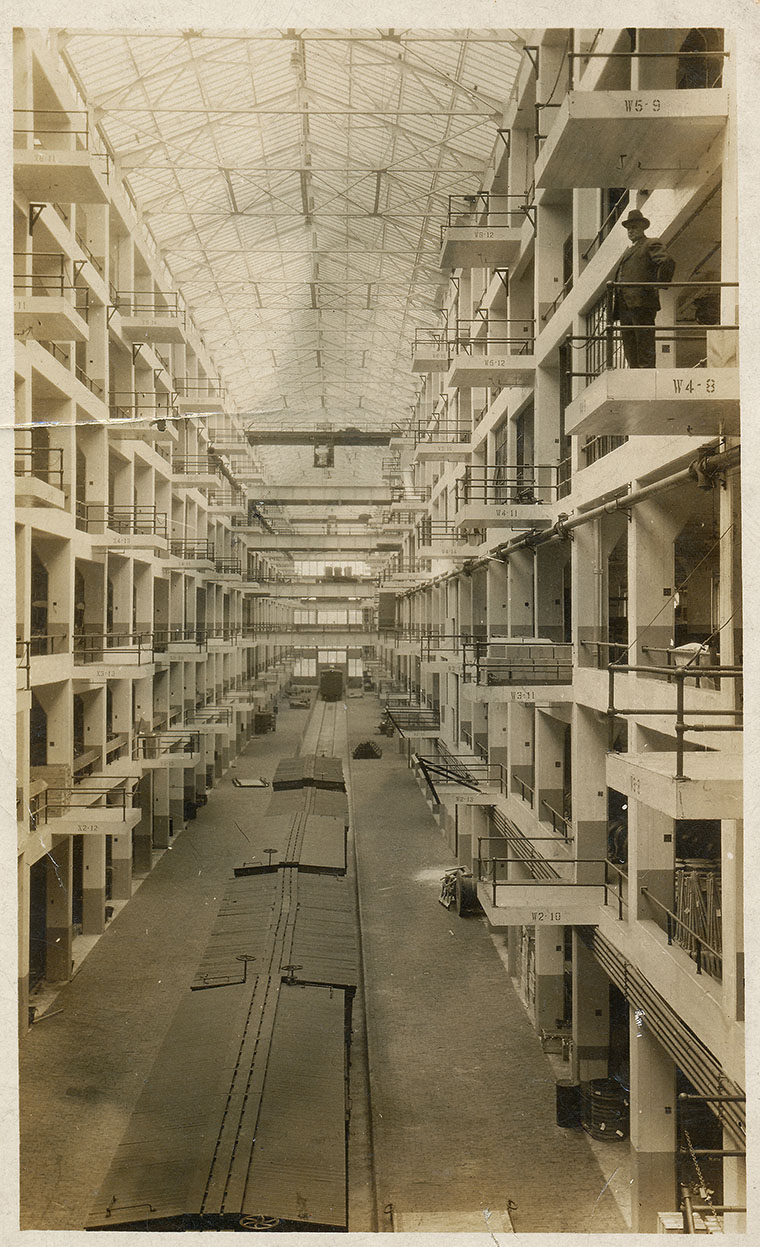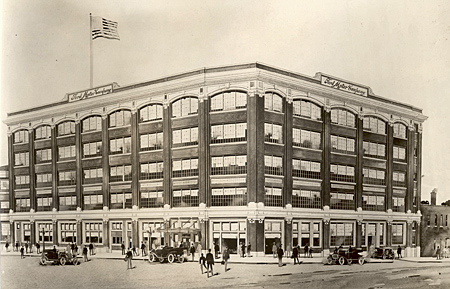


Framed or unframed, desk size to sofa size, printed by us in Arizona and Alabama since 2007. Explore now.
Shorpy is funded by you. Patreon contributors get an ad-free experience.
Learn more.

- Baldwin 62303
- Baldwin VO-1000
- Cold
- No expense spared
- Tough Guys
- Lost in Toyland
- And without gloves
- If I were a blindfolded time traveler
- Smoke Consumer Also Cooks
- Oh that stove!
- Possibly still there?
- What?!?
- $100 Reward
- Freeze Frame
- Texas Flyer wanted
- Just a Year Too Soon
- WWII -- Replacing men with women at the railroad crossing.
- Yes, Icing
- You kids drive me nuts!
- NOT An Easy Job
- I wonder
- Just add window boxes
- Icing Platform?
- Indiana Harbor Belt abides
- Freezing haze
- Corrections (for those who care)
- C&NW at Nelson
- Fallen Flags
- A dangerous job made worse
- Water Stop
Print Emporium
Ford Motor Company: 1910

Circa 1910. "Ford Motor Co., Detroit, Michigan. Highland Park plant." 8x10 inch dry plate glass negative, Detroit Publishing Company. View full size.
Inside the addition c. 1913
Maybe the only "family photo" of the interior, which Edward Gray, Ford's chief engineer, designed the inside of. Gray worked with Albert Kahn, doing much of the workflow design as Kahn designed the shell. Gray joined Ford Motor late 1909 and was key part of the design of the Highland Park Model T plant from that point to 1915, when he left Ford Motor.

And not one car? Not producing yet.
Since this photo is dated 1910 it could be that no cars were in production there yet as that started in 1910. Although difficult to tell for sure it looks like the back end wasn't there.
Although many may credit Albert Kahn for the building it was a cooperative effort, Kahn designing the 'shell' that went over the floor layouts directed by Edward Gray (check Wikipedia and other sources). My grandfather worked for him directly from their days together at Riverside Engine Company in Oil City, 1906 to 1909, when Ford hired Gray to be his Chief Engineer and Construction Engineer. Grandpa was his draftsman and stayed with Gray even after his days at Ford (Gray left Ford in 1914 to start his own construction work, developing 'Grayhaven' where Gar Wood eventually built is Detroit River mansion.)
Reference, "My Forty Years With Ford" by Charles E. Sorensen, p 125-126 (Available to view on Google Books)
My great-great-grandfather
My great-great-grandfather did carpentry work in the construction of that Highland Park plant. Later, his son, his son, and his son (my dad) all worked for Ford's in various skilled trades. What is extremely cool is that I now live less than a mile from the building that was the Portland, Oregon Ford plant. I knew it was an Albert Kahn design the moment I laid eyes on it.
Ford assembly plant in Shadyside, Pittsburgh
Following up on Jeffrey Jackucyk's comment, here is a drawing of an apparently Kahn-designed Ford assembly plant and showroom in Shadyside, Pittsburgh. The present-day structure was not in the best state of repair and has been most recently used as a party store selling paper and plastic items for birthday parties etc. The building is now being renovated (hopefully with some level of historical preservation) by the University of Pittsburgh Medical Center. I didn't know how to embed the Google Maps street view photo as Jeffrey Jackucyk accomplished, but typing in "Baum Blvd. and Morewood, Pittsburgh" in Google Maps will suffice. It is on the SE corner at 5000 Baum.
The building was immediately adjacent to a railroad spur in a hollow/valley (~125 feet below the roof). From the rail siding, far below street level, an elevator lifted bins of parts to different floors. On the top floor, workers started by connecting the chassis and wheels. The assembly line then operated by gravity. Workers rolled the chassis down a ramp to the floor below, where other workers installed additional components and built out the car. On each floor, at each stage, workers added parts then rolled the car down another ramp. The finished car ended up in a parking area behind the building, at street level. There was even a well-appointed showroom on the first floor (which became the party store until recently), where customers came to kick the tires and buy the vehicles.

Bonded Rails
At the extreme right side of the photo you can see the cables that provide a good electrical connection between two pieces of rail. The electricity to power a streetcar is typically 600 volts Direct Current, and the positive side is the trolley wire, with power collected through the trolley pole. The negative side is the track, and the power connection is made from the steel wheels to the rail. Where the two pieces of rail are bolted together, it is necessary to use a copper cable to ensure a good negative return to the substation. The last streetcar to run on Woodward Avenue was in April of 1956.
The Ford River Rouge plant had thousands arrive and leave by streetcar at shift change - there was a special station with prepaid fares and multiple loading platforms. Here is an interesting fact from "River Rouge: Ford's industrial colossus", by Joseph Cabadas:
"Filled with wanderlust, Henry went to Detroit in 1879 at age 16 and briefly worked at the Michigan Car Company, building streetcars."
Newly built Complex
The Albert Kahn designed complex at the corner of Woodward and Manchester didn't start pumping out autos until the late summer/early fall of 1910 and it wasn't until 1913 that the automated assembly line shifted into gear.
I'd bet that this photo was taken in june/july of 1910.
Dirt!
So unusual to see the great Woodward Avenue as a dirt road! Woodward has the distinction of having the first mile of concrete paved road, completed in 1909 for the princely sum of $13,537, starting 6 blocks north of here at McNichols Road (6 Mile road) and running to 7 Mile Road. Had to have something to drive those new Fords on!
Properly Attired
Mens dress etiquette of the period was that you did not wear just a shirt sleeve in public, unless doing physical labor. Either you were in a jacket, with or without vest, or just a vest. Hats were optional, but the style of the day. Both are properly dressed.
No Parking?
I suspect that this is the "before" photo. The employees ride to work on the electric trolley car tracks out front. Then they make the automobiles to drive tomorrow, so that they will need a parking lot.
One story is that Henry Ford thought that he had to pay his employees enough to buy his cars that he sold at a price low enough that they could afford. Otherwise, his mass production methods would just build up unsold inventory!
Kaaaaaahn!
Albert Kahn designed many of Ford's early facilities, not only in Detroit but around the country. There's still one of his Model T assembly plant here in Cincinnati, opened in 1915 and recently placed on the National Register of Historic Places and restored as an office building. The design is quite a bit more sumptuous than the one pictured above, though being only a fraction of the size it was certainly easier to afford more embellishment. I wonder if the Highland Park factory used similarly dark red brick. I've noticed that many of these glass plate negatives dramatically underrepresent the darkness of red brick buildings.
I Can See Clearly Now
So that's what a factory looks like before the windows get dirty, painted over, broken, and boarded up. Wow!
Albert Kahn's Old Shop
This is Albert Kahn's Old Shop of 1908-1909, the first of his many factory designs for Ford. It is perhaps the largest multi-story "daylight" factory ever built, and it employs Kahn's patented technique for reinforced concrete construction (the Kahn System). Kahn developed this system together with his engineer brother Julius; it was first employed in Building No. 10 for the Packard plant in Detroit in 1903. The immensely long Old Shop (800+ feet - we can see only about 1/3 of it here) would soon be joined by Kahn's design for Ford's "New Shop," which was built perpendicular to this building along the street at the right (Manchester Parkway) and is still standing today. Most of the Old Shop was demolished in the 1950s. Thank you, Dave, for this beautiful picture!
And not one car.
How can this be? I feel so let down.
























On Shorpy:
Today’s Top 5